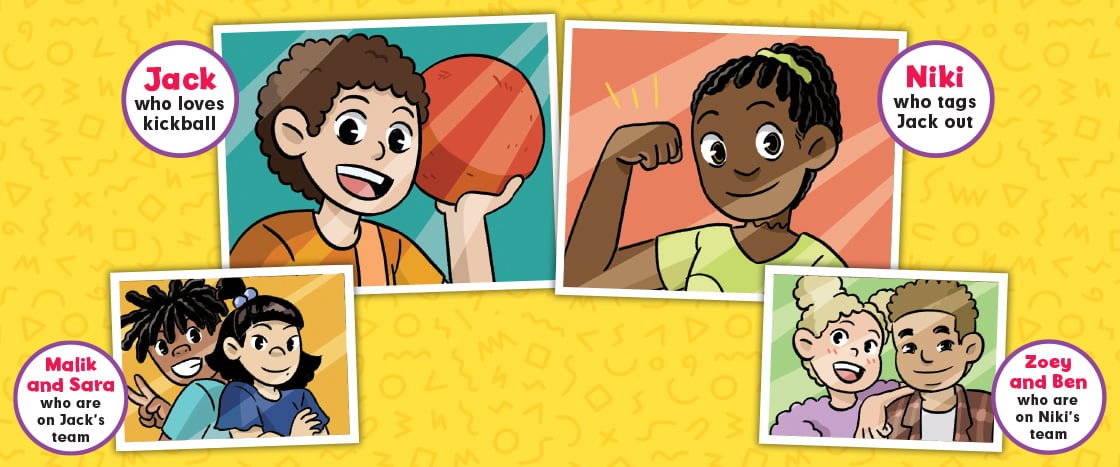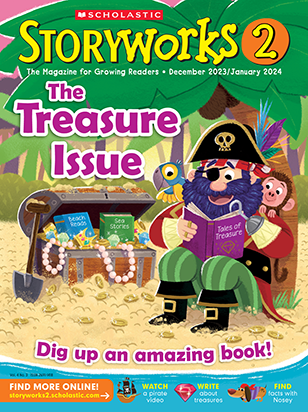
Shannon Wright
Pine School Pals #3: Kickball Clash
Meet the Pine School Pals. This week, two of the pals are having a problem. As you read, think: How could they solve the problem? When you’re done reading, you’ll finish the story!
By Lindsey Owen
From the December 2022/January 2023 Issue
video
(1)
Activities
(4)
Download All Quizzes and Activities
Skills Activities
Quizzes
(2)
Quizzes
(2)
Answer Key
(1)
About the Story
CASEL Social and Emotional Learning Focus
Self-awareness: demonstrating honesty and integrity
Step-by-Step Lesson Plan
1. BEFORE READING
Watch the Video “What’s in a Comic?” (10 minutes)
- This video teaches kids about the features of a comic.
- Before watching, tell kids to look out for four features they might find in a comic.
- After watching, ask for kids’ help to fill out a list of comic features on chart paper. The features mentioned in the video are panels, speech bubbles, thought bubbles, and onomatopoeia.
- Tell kids to look for those features in the mini graphic novel. They can fill in our “Comic Features Hunt” skills sheet after reading.
Set a Purpose for Reading (5 minutes)
- Open your magazines to “Kickball Clash.” If the class has read the previous installments of the Pine School Pal series, they know that they—the readers—will be in charge of providing an ending to the story.
- Ask your class to pay attention to the characters’ actions. Students can start thinking about if they think the characters are behaving in the best way.
- After they read, they’ll discuss what the characters should do next.
Text Preview Bookmarks (5-10 minutes)
- Our skills page has both fiction and nonfiction options for kids to cut out to help them preview the text. They can use the fiction bookmark for this story.
2. READ THE STORY (10-15 MINUTES)
- Kids can read this story individually, in small groups, or as a class.
- These stories are also great to read as short plays that kids can perform for others in the class!
3. DISCUSS THE STORY
- The stories in the Pine School Pals series ask students to brainstorm their own solutions to the problems the characters face. After students read the mini graphic novel, it’s time to have a class discussion.
- Ask students the questions on page 17. They will likely have a variety of opinions and answers, and that’s OK. There is no one right answer. The point is to get kids thinking and talking. These discussions can help them when real challenges arise in the classroom.
- Write down kids’ ideas on the board or chart paper.
4. AFTER-READING ACTIVITIES
Extend the Story With an Activity (20 minutes)
- The comic ends with Jack asking readers for advice. What should he do? We give you two versions of a page that students can use to share their opinions and create their own ending to the story. One version of this skills page has more writing for students to do, and one has less.
- Tell students they will be finishing the story on this skills page. Students can fill the page out individually or they can discuss their responses and fill it out in pairs or small groups. They can use the earlier classroom discussion to give them ideas for what to write.
ELA Focus: Comic Features Hunt (10 minutes)
- Pass out the “Comic Features Hunt” printable.
- Kids can use the mini graphic novel to fill it out and learn about the different features of comics/graphic novels.
Assessment: Quiz (10 minutes)
- Pass out the quiz to assess comprehension of the story.
- We also offer a lower-level quiz.
- Both quizzes are now available in multiple- choice and written-answer formats.
Independent Learning:
Whole Issue Scavenger Hunt (30 minutes)
- We created a scavenger hunt for several stories in this month’s Storyworks 2, including the mini graphic novel. The scavenger hunt can be done by students independently at home or during class time.
- This is a self-contained group of slides that guide your students on a scavenger hunt through the whole issue. It’s not only fun, it also helps them make text-to-text connections.
Text-to-Speech
